1.
Whenever traveling gets really bad, I like to pretend I'm describing the situation to a friend. I think how, once this is all over, I'll look back and laugh at what's going on and realize that it wasn't so bad. It also helps me imagine just how bad it could get and realize what's likely/unlikely to happen. And that's what I thought to myself on the tuk tuk on the way to Fort Kochi.
We'd arrived in Mumbai the night before at around 1a.m., a little later than expected, but not too delayed. We waited in customs for a while and then when we finally got to the front of the line I was sent to the back as I'd apparently used the wrong coloured ink; alas the permitted colours are common knowledge to only Indian bureaucrats. This was only a temporary setback as we soon got our bags and were on our way to the hotel...
...it was then about 2:30 - or 4:00am Bangkok time; India is an awkward 90 minute time zone difference. As we got into the room we looked down at the bed and it was swimming in bugs. We were so exhausted that we prayed they wouldn't bite and just slept on top of everything; we were up five hours later to find the room choked with diesel fumes and us looking for a flight.
We checked out and asked the motley assortment of people who may or may not have been hotel employees at the front desk if they'd get us a cab to the airport (a mere two kilometers away, but in the chaos of Mumbai it might as well be on another planet). This started a flurry of discussion whereupon the bellman asked the front desk clerk who called out to a man who was dressed like a retired military officer who chased down three guys in t-shirts who went out looking for a cab.
We were told to wait five minutes and ten minutes later the scouts returned to the general to debrief him. The whole process ran in reverse and the bellman finally informed us that a taxi could not be procured as there was apparently a national strike. He had a bizarre way of making it feel like if we'd only been 30 seconds earlier, we would have missed the strike - which was, of course, ridiculous.
At this moment, a man who had been quietly sitting in the corner reading the Hindu Times told us that our flight was probably cancelled and we shouldn't worry about leaving Mumbai that day. A quick call to the airport proved it otherwise so he surprisingly offered his car to get to there. It turned out that he was going to a training session (he was in the merchant marine) and we could have his driver take us to the airport after he was dropped off at the training center.
Perfect! We all piled into an undersized and equally underpowered Tata just as the monsoon rains began to erupt. It being Mumbai, the streets were clogged with traffic (albeit oddly devoid of cabs) and we gazed jealously at the speed made by the throngs of pedestrians found everywhere in the city.
We finally began to move but we were left with the impression of going nowhere in circles. At one point we found ourselves in Bollywood, being shown where all the different studios were (I just want the airport!). At another time we were driving through a stable of cows, waiting for them to find some garbage tasty enough to motivate them to leave the road (Airport, please!). All the while the rain painted the city black.
After two hours in the car - and maybe 10 km of driving - we made it to the airport exactly as our flight was taking off. Since this sort of thing happens all the time in India, it wasn't a problem to change our ticket to a later flight to a nearby town (Kochi instead of Trivandrum) - and heck, Kochi was actually a more convenient place for us to go to. A little frazzled, but calming down, we hung out in one of the Mumbai airports many cafes (ironically, the domestic airport is the most relaxing place in the city; only ticketed passengers are allowed inside).
Getting to the flight was interesting as, depending on which sign we looked at, we were either going to Kochi or Cochin (damn you India, pick the British or Indian name, but not both!), but we managed to get on the bus to our flight and there we got to see this walking cliche:

Two hours later we were on the ground in Kochi and our bags came within seconds! We got a cab to the city after confirming with the dispatchers that we'd be able to catch the ferry there to Fort Kochi (the heritage district is on a nearby island).
When we got to the ferry terminal - a dirty patch of grass with a concrete bunker at the end - the cab peeled away and it was eerily quiet. As we walked to the terminal, a man came up and told us the terminal was closed. There was a nearby tourist office where the attendant told us we were out of luck as it seemed the strike was national, not just Mumbai cabbies, and there was no possible way on earth to get to Fort Kochi and we should go to a nearby hotel - and then he literally went back to sleep.
Except that this wasn't true. Fort Kochi is connected to the city (Ernakalum) by a bridge and you can almost see the bloody thing from the tourist office. Unfortunately, our cab had left and, due to the strike, there weren't any around. So, we eyeballed our scale-free tourist map and started walking in the 30 degree heat. (At this point you may be wondering why the folks at the airport didn't tell us to take the cab there due to the strike; I'm still wondering why)
As we walked, we got quite a few stares. I don't think anyone could believe that we were walking there but we had no desire in spending a night in a crummy hotel on the mainland where there would be literally nothing to do. After an hour of walking and almost no sleep in the previous 24 hours, we were starting to fade. And at that moment, the greatest entrepreneur in India, a man with a tuk tuk who had said "damn the strike, I'm going to make some money!" came by and offered us a ride. I could have cried; he quoted us a price he probably thought usurious but he had severely underestimated us and we folded like wet paper bags. Soon we were in the back and rocketing towards Fort Kochi with the wind in our hair and dust in our eyes.
And that's when he very seriously asked us if we had our booking. Panic struck my sleep-deprived brain. Is this a polite way of saying "you guys are idiots for going there as there are no rooms available" or is he just trying to get us to book at a friend's house? This is going to be like Mt. Bromo where we arrive and can't find anything and end up in a home stay where the room and accoutrements haven't been washed this century. And that's when I decided I'd start telling this story to myself.
We looked around and realized that we hadn't seen another westerner yet (there were only two on our otherwise 3/4 full flight) so there had to be rooms available. Yes: there would be a beautiful room with a fresh, comfortable bed and a hot shower and we'd nap and get a meal and sleep again and laugh it off the next day. Which, is actually exactly what happened.
2.
Kerala is the spice market to the world. One of the highlights of Fort Kochi is walking around and observing the chaos that is the spice trade. The stores of Market Drive are lined with spice wholesalers who show off their wares:
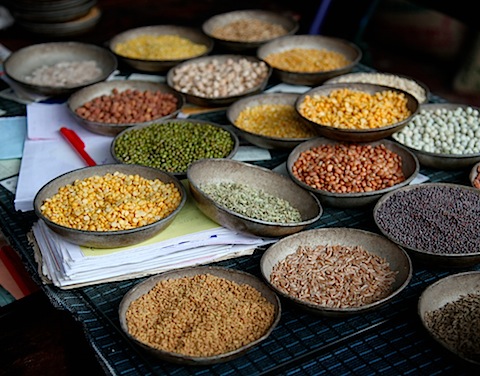
Outside their shops, workers move more spices and 55kg bags of rice than you can imagine; pigeons greedily eye the spillings:

When you head inland (up to Munnar), you reach the Western Ghats where every square inch of arable land seems to grow tea or eucalyptus or cardamom or any of a variety of other herbs and spices:
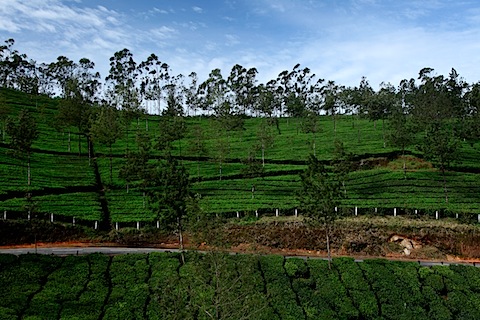
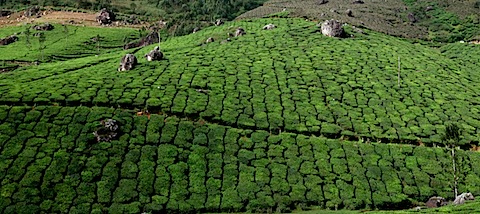
Traffic stalls as buses randomly stop to let their passengers alight and gaze at ladies cutting tea leaves.
Every town has multiple spice farms where you can go and taste the various goods; you leave with a curious concoction of flavours in your mouth. Here's a sample of some of what we saw.
Mace covering nutmeg, as demonstrated by hand model Wendy:

Hibiscus; the leaves are used to create shampoo (next time you see one, tear a leaf apart to feel the gooey sap):
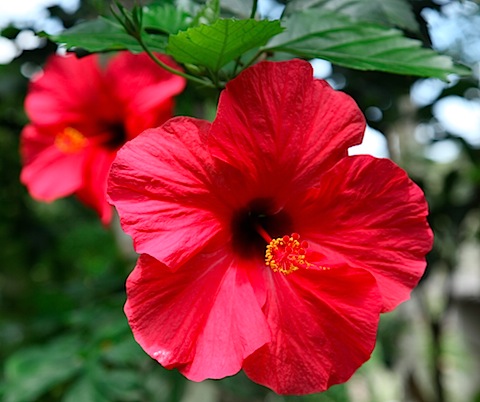
Tumeric:
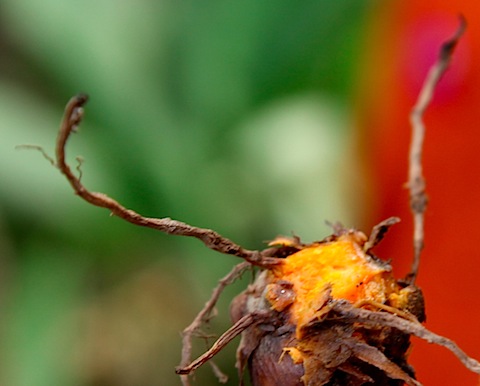
The hottest peppers you'll ever try. Spice appears to be inversely proportional to size:
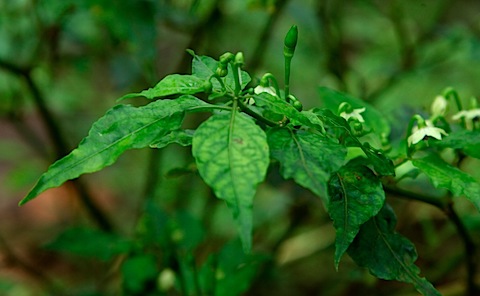
And cardamom (turns black when ready to harvest):
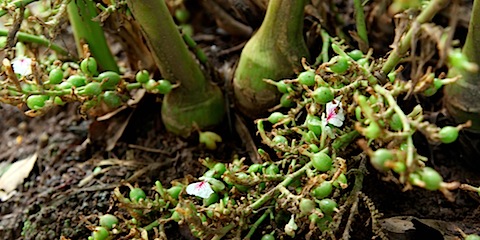
There seems to be a special place in Keralites' hearts for cardamom. In addition to acres upon acres of the stuff alongside the roads, there's a research center into it, numerous hotels and restaurants are named after it (only "tiger" seems to be a more common hotel descriptor) and there are delicious cardamom cookies too:

3.
Fort Kochi is a great place to start a visit to India and it also shows you just how complex the history is here.
The original Hindus arrived from the north thousands of years ago and then shortly after JC's crucifixion, Christianity appeared here; India had Christianity before Europe. Over time, many cultures have come and gone and left traces of themselves.
The port contains massive Chinese fishing nets, indicating there must have been trade with them at one point:

Vasco de Gama came here in 1498 and was briefly (14 years) interred at St. Francis' Church before having his remains returned to Portugal:
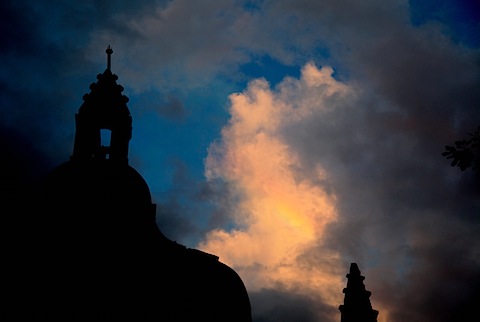
The Dutch came next and left their gravestones inside the fort and the emblem of their trading company (VOC for the Dutch East Indies Company) nearby:
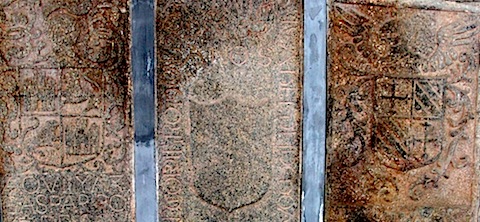
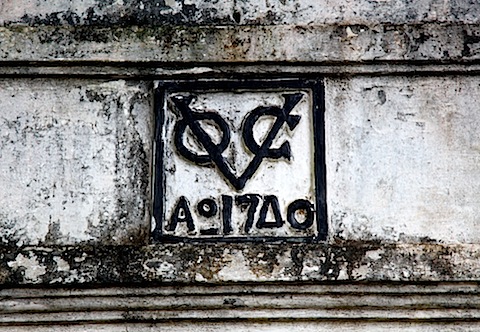
Most recently it's been the Brits, who have left the area with some beautifully decaying colonial buildings:
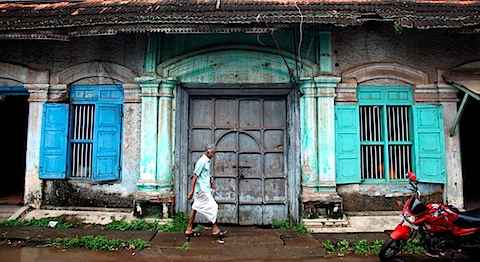
And it's not just these folks. The muslims came to Kerala shortly after the establishment of Islam and a sizable chunk of the population has converted. There were a lot of Jews too (now mostly emigrated to Israel) who lived in the beautiful part of town that's now literally called "Jewtown":
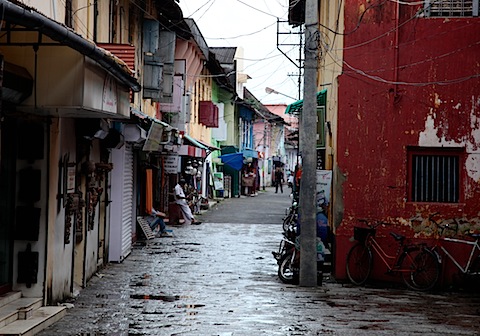
3.
One of the highlights of our trip so far has been taking a backwaters houseboat tour in Kerala. The coast of Kerala is separated from the mainland by a series of waterway and dykes. You can rent a houseboat and lazily amble through these backwaters. Life moves like molasses there and time seems almost as still as the water.
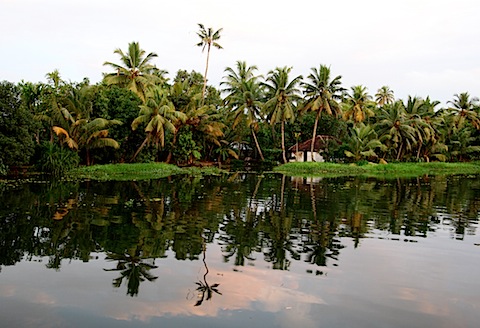

The people here almost live on the water. They build their houses on the narrow ledges between the rice paddies and the waterways. Their kids take the local school boat instead of school bus. And going anywhere requires a punt.

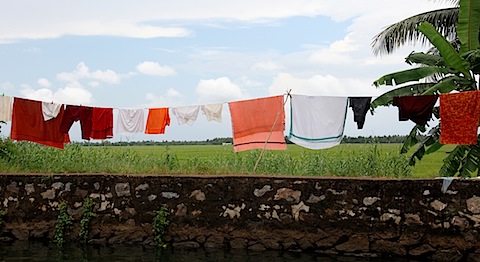
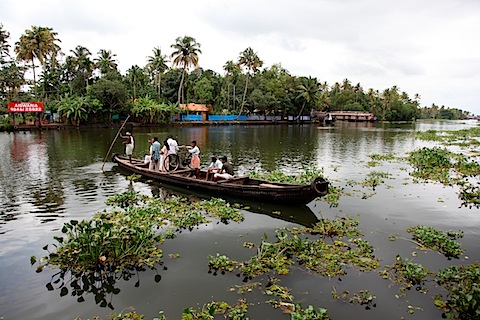
LIfe here is bucolic; at night the sounds of families singing together echoes across the otherwise still landscape. Fireflies come out and blink in the sky. You get a sense of why Gandhi was obsessed with building an India that was centered around the village.
The area also gives you a few insights into other aspects of India. For instance, there are many Christians in Kerala and sometimes they are accused of proselytizing, raising frictions with the Hindu supermajority (80% of Indians are Hindu vs. about 2% Christian). The Christians haven't done much to help their cause by creating some unique-to-Indian-Christianity traditions. Such as the flagpole that they have outside all their churches; it looks conveniently like the flagpoles Hindus use for their ceremonies:
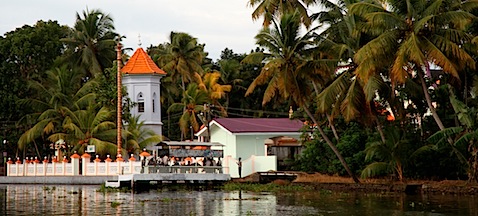
Another insight on India. This house is far and away the largest house we saw. In fact, there are actually two houses: the main house (shown below) is the owner's; the second house is for his wife's family. That's his boat outside.
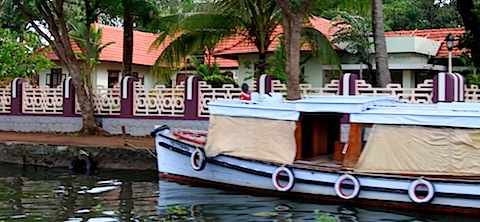
So who is this rich person, this role model for all, this beacon of the future of India?
None other than the local federal politician. Hmmm...
5.
I received a lot of advice on where to go in India, and unsurprisingly some of the best advice came from my Indian friends. One insisted that our trip would not be complete without a visit to Periyar Tiger Reserve.
The reserve is based around a series of lakes, formed from by a dam in 1895 (the park itself was declared by the Maharaja in 1935):
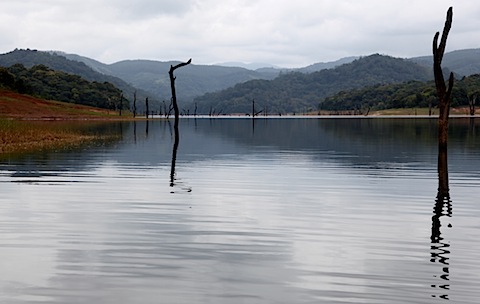
You can take a bamboo raft along one of the lakes (it's closed to boats, so you'll have it to yourself) and you'll almost certainly see gaur (Indian bison) and lots of boar along its banks:
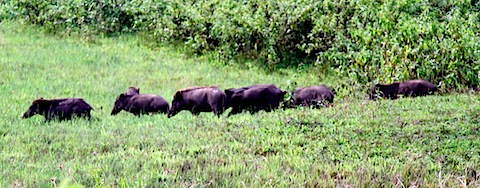
Alternatively, you can climb the hills and roam around, possibly scaring one of the afore-mentioned bison:
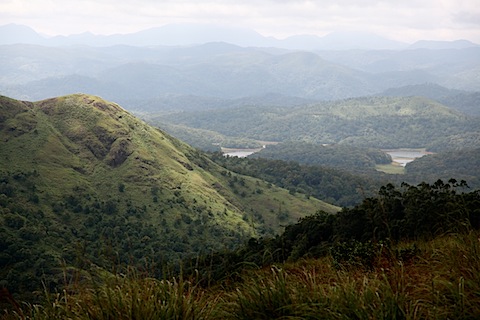
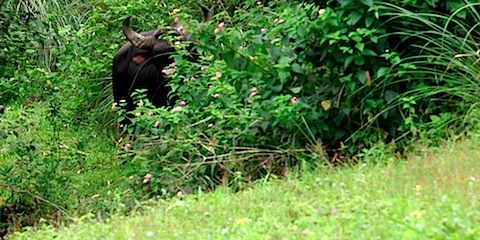
Irrespective of which you choose, you'll be surrounded by wildlife. This is a birder's paradise, with cormorants, egrets and kingfishers hanging out in the lake while eagles and parrots fly overhead. Hornbills belligerently bray from the underbrush; they're rarely seen but the sound of their wings disturbing the air can be heard as they fly.
Black butterflies with iridescent blue tinges chaotically whirligig through the jungle while white and black monkeys (local terms, not mine) jump from tree to tree. Giant malabar squirrels scurry from place to place. Touch-me-nots recoil from you and giant bats can be seen in bamboo groves.
This all takes place under the hidden eye of the tiger (you almost certainly won't see one; our hotel owner worked in the park for 13 years and saw two; we had to satisfy ourselves with a footprint) and reminders (dung and footprints) of the wild elephants nearby.
In fact, if you spend a few days in the park, you'll almost certainly see some elephants.
We saw two different sets. The first was in some hills half way through the boat ride. The trip had been a little slow up until then so we were taking random photos of the flowers when all of a sudden...
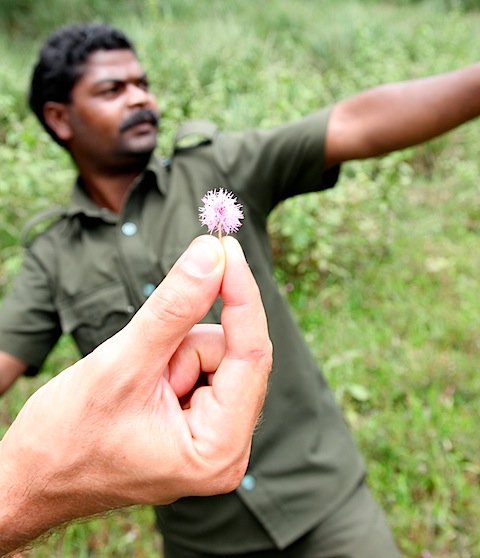
...a few elephants trundled out of the bush partway down the hill, their young in tow. They pulled at some bamboo and then noticed us. One trumpeted at us and our guide told us that it as time to go as they thought we threatened them - even though we were probably 1,000 feet away.
The second set of elephants were seen on the hike out after the ride. We came to a clearing and some elephants were walking along. They never even saw us and were eventually swallowed up in the aptly named elephant grass.
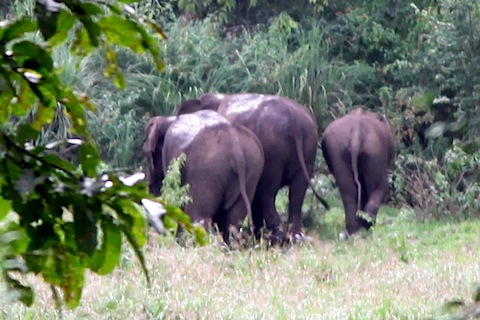
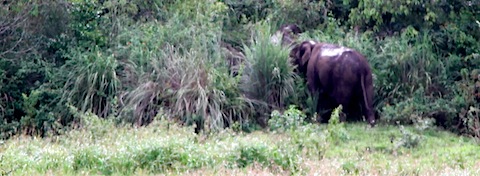
Afterwards our guides mentioned that they could hear the elephants talking to one another (alas, the frequency was too low for my loud concert-ravaged ears to pick up).
Now, a word on the danger involved. Because Periyar is the greatest and most successful and \<insert superlative here> park in the world, as any Indian will tell you, and tigers are so dangerous (even though you won't see one), you need to be armed. But since you would melt in fear at the sight of a tiger or a charging gaur, you need a strong local man to protect you. And the Indian army has stepped into the fold.
Here's our guard. Thanks to him, all members of our party made it back alive.

We had a great time in Periyar (square inch for square inch, it could be one of the best parks in the world), although there was definitely a little bit of a culture clash going on, mostly due to this man below:

Yup, we were out in this beautiful still lake, surrounded by nothing but the chirping of birds and braying of beasts, when he started talking on his cellphone. Repeatedly.
We (Wen, I and the two Germans on the rafts with us) were put off by this, but chalked it up to cultural differences. However, later in the day, we snapped.
We were coming back and the guy had given his cellphone to his young child. The kid started using it to play some Shakira song from the World Cup. I politely asked him if he'd turn it off; none of us had come into one of the few truly wild places in India to listen to crappy pop music on an even crappier speaker.
Alas, this was misunderstood by the kid and his family who thought that I was really impressed by the fact that the cellphone could play music. One of the Germans went nuts and in a truly Teutonic way began screaming about how we'd come for silence and turn off the damn cellphone, etc.
The cellphone was turned off and we rode awkwardly in silence for a few minutes but then it was forgotten.
6.
Our last stop in Southern India was our only stop in Tamil Nadu: Madurai. People come here for the massive Minakshi Sundareshvara Hindu temple.
This stunning place was originally built in the 7th-10th centuries and greatly expanded between the 14th and 18th centuries. In the past 60 years they've started painting the 50m tall gopuras (the gates to the temple; arranged along the cardinal axes) multiple colours:
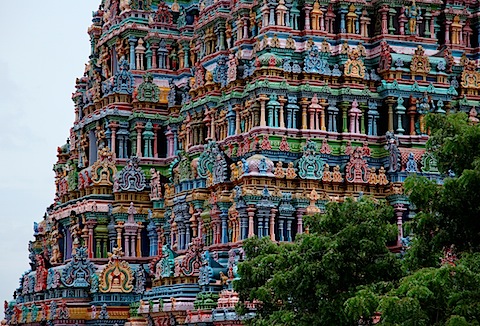

Inside, Hindus from across the country pray and light lanterns. The smell of spices and cloves from burning oils and incense wafts through the air. A band plays traditional prayer music. And colour explodes around the Thousand-Pillared Hall:


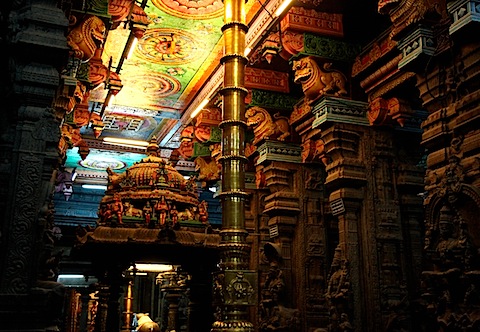
It's one of the most incredible places of prayer I've been to anywhere.
7.
Oh, the Indian food. It is some of the best food I've ever had. Check out this cashew curry (from Ginger Restaurant in Fort Kochi):
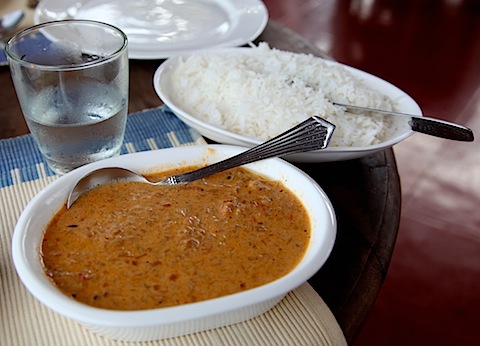
It came with a Kerala specialty: appam. It's a mix of ground rice and fried coconut and is served instead of a chapatti.

At Shala in Fort Kochi we had one of the best vegetable curries ever (on right). It also came a delicious side: just a mix of shallots, fried coconut and molasses.

They also served us puttu as a side: steamed wheat flour (kind of like couscous) instead of rice:

In Madurai we went into the oddly named Manorama for a vegetarian meal. It turned out to be one of the most unique culinary experiences I've ever had. We were whisked to our seats and suddenly two banana leaves appeared before us. A man holding three metal tins came by and started ladling out various curries. Then bowl after bowl of different sauces began arriving (sweet, yogurt-based, curry-based, etc.). Rice appeared, as did some pappudoms. Mercifully, spoons arrived specially for us (eager readers will recall the last time - Yogyakarta - that I tried to eat with my hands).
We were instructed to mix it all together; since none of the staff spoke English, this was through a series of entertaining hand gestures. We also had to learn hand gestures for "stop, I don't need any more food!" as the service was so great they almost wouldn't take no for an answer.
Here's Wendy getting ready to enjoy the meal:

If you look closely at the photo above, you might notice a few black dried peppers on the right middle of the leaf. The meal came with an accompanying set of dried and salted peppers (some hot, some just flavourful). I'd never tried these before and am writing this as an addict in withdrawal; I need to find them again.
Our last meal in the south was a breakfast dosa in the Chennai airport. I hadn't found one yet (they're don't seem to have been popular in Kerala) so I was glad to finally taste the real thing:
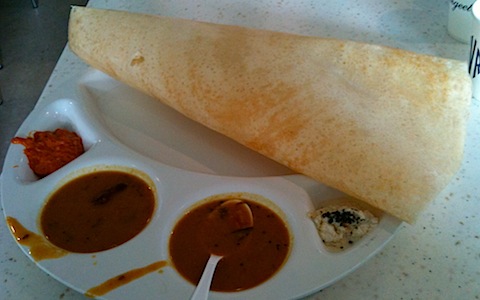
And finally, the Indians have a national sweet tooth (which suits me perfectly). Here are some of the sugary sweets you can buy in one of the local bakeries (just don't look for bread there; it's just sweets and pastries):

Numbers one and four are particularly good - kind of like Maple sugar and marzipan respectively. Number two is a cashew cookie and it's neighbour - laddu - has a clove in the middle. The one on the right is like a ginger-based version of a rum ball.
8.
In keeping with the traditions of this trip, another country and another fruit. This time it's musumbi, which is like a tart orange. It makes a mean juice:
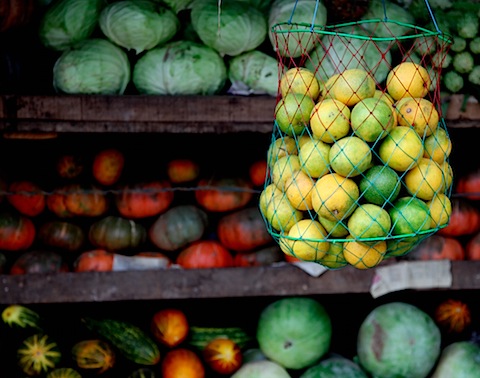
9.
And a few random closing thoughts:
- On September 10th, I reached a special club. In fact, it's a club that as far as I know only included my buddy Tom. It's the club for people who have eaten curry for all meals in one day (okay, maybe it's really for Westerners as there are about a billion Indians who are standing members of this club). On the 10th, I started the morning with a vegetarian curry followed by a chicken curry for lunch and another vegetable curry at dinner. Curry trifecta!
- Internet upload speeds here are faster than New York, providing further evidence of the continued failure of Time Warner and the need for the feds to do something to force an upgrade of the system. Alas, the power grid is much more robust in New York than here; those upload speeds were useless when the power went out
- When driving through fog, Indians put on their four way flashers, not their headlights. Thought it was an interesting way to deal with it